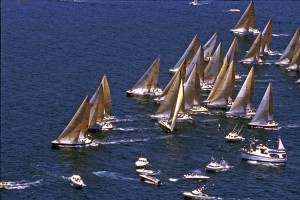
In Division 6, Relentless, the One-Design 35 being doublehanded by Tim Fuller and Erik Shampain, has a ten-mile lead over the crew on Narrow Escape.
After sailing through wind ranges of 8 to 15 knots immediately following Monday’s start and making a number of headsail changes, Divisions 6 and 7 Transpac crews went over the top of Catalina Island and settled into steadier conditions. Relentless leads and is 2,100 nautical miles from the finish line off Diamond Head and Lynx, the 114-ton tall ship, is finding difficult to get the momentum going. Lynx has 2,165 nautical miles left to go on the 2,225 nautical mile racecourse.
Alumni from the 2007 Transpac Morning Light crew are sprinkled throughout the 51-boat Transpac 09 fleet. Two of them, Kate Theisen and Graham Brant-Zawadski are up for another once-in-a-lifetime experience during this Transpac. They have joined the Lynx crew. America’s Privateer, Lynx, a 122-foot square topsail schooner, travels 7,000 nautical miles each year to ports along the West Coast and Hawaii, serving as a living history museum and classroom for the study of early maritime history and its role in establishing America’s freedom, as well as earth, life and physical science.
Charisma, one of nine foreign yachts in this year’s Transpacific Yacht Race, is off to an early lead in Division 7. Alejandro Perez Calzada and his crew of 11 are racing this 57-foot Sparkman & Stephens design. Aside from one German, the entire Charisma crew is Spanish. All crew members are sailing their first Transpac. Their goal is to have a good time and have a respectable finish within their division.
Between the Sheets, Ross Peralman’s, Jeanneau 50, which won the Aloha A division in the 2007 Transpac, is approximately 15 miles behind Charisma.
Nineteen boats comprising Divisions 3,4 and 5 start on Thursday, July 2nd at 1300 off of Point Fermin. Five Santa Cruz 50’s, including hull #1, Roy’s Chasch Mer, constitute Division 5. Half of the boats in Division 4 are Santa Cruz 52’s. Reinrag2, the overall winner on corrected time for the 2007 Transpac, is also in Division 4. Division 3’s entries include two Japanese and one Mexican boat and Bruce Anderson’s comfortable and fast, Free Range Chicken.
With 44 races starting in 1906, the Transpacific Yacht Race to Hawaii is well into its second century as the longest of the two oldest ocean races in the world. The first race was the year of the great San Francisco earthquake, which literally altered the course of the event.
The race was inspired by King Kalakaua, the revered Hawaiian leader of the late 19th century who believed that such an event would strengthen the islands’ economic and cultural ties to the mainland. But it didn’t happen until Clarence MacFarlane, a Honolulu racing sailor, invited several contemporaries in San Francisco and Los Angeles to race to the Hawaiian Islands. The race was scheduled to start in the early summer of 1906, but when MacFarlane sailed his 48-foot schooner into San Francisco Bay he realized there would have to be a change of plans. The city lay in ruins following the great earthquake 27 days earlier.
But MacFarlane wasn’t easily discouraged. He simply changed the starting point to Los Angeles, and except for one nostalgic return to San Francisco for the start in 1939, the race has started in Southern California ever since. The starting line is now off the bluffs of Point Fermin in San Pedro at the southern edge of the City of Los Angeles. The finish is off the Diamond Head lighthouse just east of Honolulu, establishing a distance of 2,225 nautical miles.
The 2009 race will be the 45th Transpac. It has been sailed by 1,700 boats from 17 countries, including 124 foreign competitors. The race is run biennially in odd-numbered years, alternating with the Newport-to-Bermuda race that also started in 1906.
Fastest elapsed time (monohull): 6 days 16 hours 4 minutes 11 seconds, Morning Glory (Reichel/Pugh maxZ86 maxi sled), Hasso Plattner, Kiel, Germany,2005.
Fastest elapsed time (multihull): 5 days 9 hours 18 minutes 26 seconds, Explorer (86-foot catamaran), Bruno Peyron, 1997.